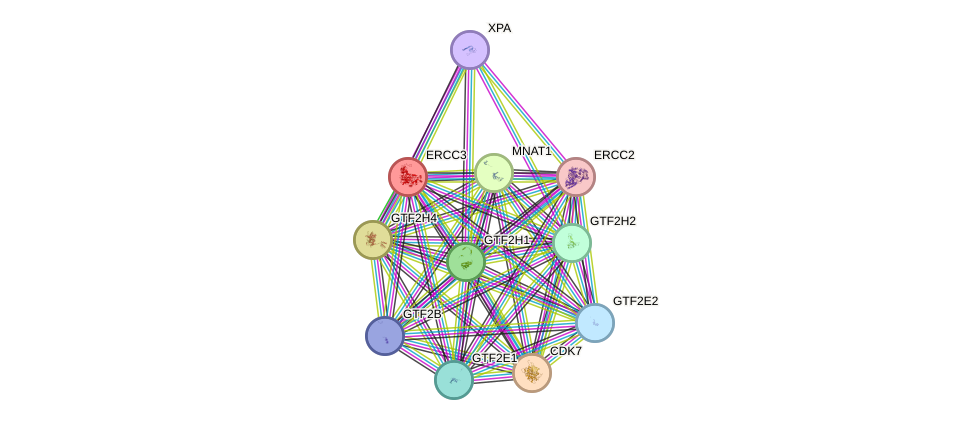GenAge entry for ERCC3 (Homo sapiens)
Gene name (HAGRID: 104)
- HGNC symbol
- ERCC3
- Aliases
- XPB; BTF2; RAD25; TFIIH; GTF2H
- Common name
- excision repair cross-complementation group 3
Potential relevance to the human ageing process
- Main reason for selection
- Entry selected based on evidence linking the gene product to a pathway or mechanism linked to ageing
- Description
ERCC3 is a helicase and a component of the TFIIH basal transcription factor [544]. Mutations in ERCC3 cause Xeroderma Pigmentosum group B [547]. Due to its role in DNA repair in association with the other ERCC proteins, some of which directly related to ageing in mammals, it is possible ERCC3 plays a role in human ageing.
Cytogenetic information
- Cytogenetic band
- 2q21
- Location
- 127,257,290 bp to 127,294,176 bp
- Orientation
- Minus strand
Protein information
- Gene Ontology
-
Process: GO:0000717; nucleotide-excision repair, DNA duplex unwinding
GO:0001666; response to hypoxia
GO:0006265; DNA topological change
GO:0006281; DNA repair
GO:0006283; transcription-coupled nucleotide-excision repair
GO:0006289; nucleotide-excision repair
GO:0006293; nucleotide-excision repair, preincision complex stabilization
GO:0006294; nucleotide-excision repair, preincision complex assembly
GO:0006295; nucleotide-excision repair, DNA incision, 3'-to lesion
GO:0006296; nucleotide-excision repair, DNA incision, 5'-to lesion
GO:0006361; transcription initiation from RNA polymerase I promoter
GO:0006362; transcription elongation from RNA polymerase I promoter
GO:0006363; termination of RNA polymerase I transcription
GO:0006366; transcription from RNA polymerase II promoter
GO:0006367; transcription initiation from RNA polymerase II promoter
GO:0006368; transcription elongation from RNA polymerase II promoter
GO:0006370; 7-methylguanosine mRNA capping
GO:0006468; protein phosphorylation
GO:0006915; apoptotic process
GO:0006979; response to oxidative stress
GO:0008104; protein localization
GO:0009411; response to UV
GO:0009650; UV protection
GO:0016032; viral process
GO:0033683; nucleotide-excision repair, DNA incision
GO:0035315; hair cell differentiation
GO:0043065; positive regulation of apoptotic process
GO:0045944; positive regulation of transcription from RNA polymerase II promoter
GO:0048568; embryonic organ development
GO:0070911; global genome nucleotide-excision repair
GO:1901990; regulation of mitotic cell cycle phase transition
Cellular component: GO:0000439; core TFIIH complex
GO:0005634; nucleus
GO:0005654; nucleoplasm
GO:0005669; transcription factor TFIID complex
GO:0005675; holo TFIIH complex
Hide GO termsFunction: GO:0003677; DNA binding
GO:0003684; damaged DNA binding
GO:0004003; ATP-dependent DNA helicase activity
GO:0004386; helicase activity
GO:0004672; protein kinase activity
GO:0005515; protein binding
GO:0005524; ATP binding
GO:0005525; GTP binding
GO:0008022; protein C-terminus binding
GO:0008094; DNA-dependent ATPase activity
GO:0008134; transcription factor binding
GO:0008353; RNA polymerase II carboxy-terminal domain kinase activity
GO:0016887; ATPase activity
GO:0032564; dATP binding
GO:0042277; peptide binding
GO:0043138; 3'-5' DNA helicase activity
GO:0047485; protein N-terminus binding
Protein interactions and network
- Protein-protein interacting partners in GenAge
- TP53, ERCC2, E2F1, MYC, ERCC6, ERCC5, AR, GTF2H2, RAD52, CDC42, CDK7
- STRING interaction network
Retrieve sequences for ERCC3
Homologs in model organisms
- Caenorhabditis elegans
- CELE_Y66D12A.15
- Danio rerio
- ercc3
- Drosophila melanogaster
- hay
- Mus musculus
- Ercc3
- Rattus norvegicus
- Ercc3
- Saccharomyces cerevisiae
- SSL2
- Schizosaccharomyces pombe
- ercc3
In other databases
- LongevityMap
- This gene is present as ERCC3

